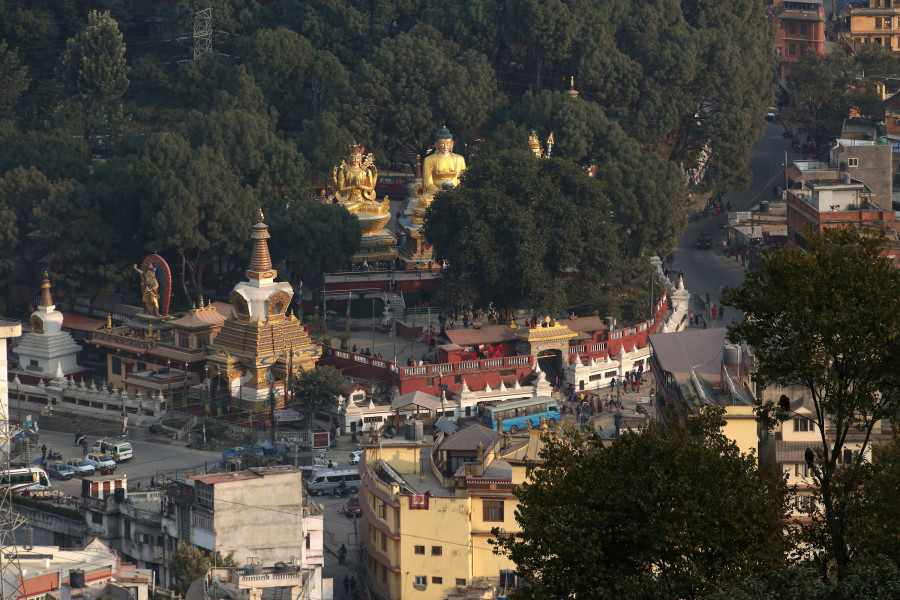Valley
Authorities yet to clear roadblock to start Ring Road expansion
Officials say obstruction at Swayambhu and land acquisition dispute at Maharajgunj have obstructed the second phase of road expansion work.
Anup Ojha
The second phase of Ring Road expansion work is still undecided as the government has yet to resolve the dispute concerning a roadside shrine at Swayambhu and acquire properties along the 8.2 km road from Kalanki to Maharajgunj to start the project.
In December 2019, the Department of Roads had said that the road expansion work would start from early 2020. A year later, the project is still in limbo.
The dispute at Swayambhu and land acquisition issue at Maharajgunj have stymied the project despite the Ministry of Physical Infrastructure and Transport on October 11 last year directing the authorities to start the road clearance work to make way for the project.
Last October, a meeting chaired by Minister of Physical Infrastructure and Transport Basanta Kumar Nembang had directed the Department of Roads and Kathmandu Metropolitan City to remove the electricity poles and trees along the road as well as relocate the high voltage transmission line between Karkhana Chowk and Sano Bhyrang.
The minister had also directed the department and the city office to remove the Chaitya (shrine) and the idols of Buddha in front of Swayambhu Park and compensate the landowners whose properties fall on the proposed road expansion site.
However, the road clearance and land acquisition work could not move forward after the plan to remove the Chaitya was opposed by local residents and the Buddhist community of Swayambhu.
Following the opposition, Minister Nembang had withdrawn the plan to remove the 1,000 Buddha idols.
“The ministry only rolled back its decision after over 4,000 Buddhist people associated with over 40 instutaions took to the street in protest,” said Sunil Gurung, chairperson of Manang Samaj Samiti, an organisation spearheading the campaign to preserve the Chaitya and the Buddha idols at Swayambhu, a UNESCO World Heritage site.
Last year, the Samiti in association with other institutions had collected 1,500 signatures to save the shrine and submitted it to the Kathmandu Metropolitan City, the Department of Roads, the Department of Archaeology, the Ministry of Infrastructure and the Prime Minister’s Office.
The Buddhist community has also raised the issue of hundreds of Buddhist faithful who performed morning quora (circumambulation) of Swayambhu stupa.
They say things could get much worse after the road expansion takes place, as the road is dangerous for elderly people due to lack of proper infrastructure.
“We are not against development, but why is the government not exploring other alternatives to preserve the heritage and infrastructure that took years to build,” said Gurung.

When the Post contacted Deepak Kumar Bhattarai, spokesperson at the Ministry of Infrastructure, to inquire about the recent development, he said he was still working to get detailed information about the issue.
“I am new at the office, so I am not fully informed about the issue. I am gathering the details from the Department of Roads,” said Bhattarai.
Rajeshwor Gyawali, chief administrative officer at the Kathmandu Metropolitan City, said the city office was coordinating with the relevant agencies and stakeholders to resolve the issue.
“The road expansion work is carried out by the Department of Roads and we have been holding meetings with the department and the local Buddhist community of Swayambhu to resolve the issue,” Gyawali told the Post.
The land acquisition issue at Maharajgunj has also not been settled for the road expansion project.
The Chinese government, which is funding the project, has said that it won’t start the work until the road section is cleared.
Arjun Suwal, chief of Kathmandu Ring Road Improvement Project, said the issue of Swyambnu can be solved through talks, but the land acquisition issue at Maharajgunj is not so easy to settle.
The authorities need to vacate 19 houses and acquire 16 ropanis of land as a part of land acquisition.
“We have managed to settle the property valuation of only seven houses. The remaining 12 house owners are reluctant to furnish the documents for their properties,” said Suwal.
Bhai Kajit Tiwari, chief of Kathmandu Valley Development Authority, said it was getting increasingly difficult to settle the compensation sum with the landowners at Maharajgunj.
“Even the government’s one year’s annual budget can’t compensate the owners, because the property value in the area is going high,” said Tiwari. “The government should make a new legal provision to compensate the landowners.”
The Chinese government was expected to submit the design of the project before October 2018. However, the government has not submitted the project report till now. Officials say, due to the Covid-19 pandemic, they could not work last year.
“We have completed 98 precent of the road clearance work. But we are having difficulty settling the issue at Swayambhu and Maharajgunj,” said Suwal.




 19.12°C Kathmandu
19.12°C Kathmandu.jpg)








%20(1).jpg&w=300&height=200)

